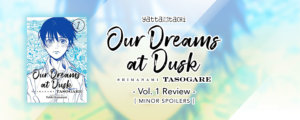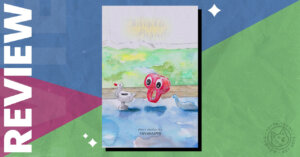Yuhki Kamatani’s Our Dreams at Dusk: Shimanami Tasogare follows Tasuku Kaname – the new kid in town, whose reputation has already taken a hit when rumors start swirling about his sexuality. As he ponders ending his life, he sees a person jump off a building. Tasuku follows the person into a drop-in center, where he meets individuals dealing with similar issues to his own. Through some reflective conversations, he finds a new place that both supports him and allows him to figure things out.
What Makes this Manga Great
It’d be unfair to label Our Dreams at Dusk as a BL series because I think it’s something more. In its first volume, the manga sets a sensitive and thoughtful tone in its exploration of a young boy coming out. It’s a complex character-driven story with an ordinary individual whose heartbreaking dilemma is one we can sympathize with.
A character simply known as Someone-san plays a key role in Tasuku’s struggle to cope with his sexuality. She’s a mysterious, quiet person whose key catchphrase is “I won’t listen,” which she usually uses at the end of some of her sentences. Despite saying she won’t listen, she does offer cryptic hints when the characters don’t notice.
One of the most important lessons stressed in the manga is the need for safe spaces. They give people like Tasuku a chance to be more open with himself and engage in discussion. His interactions with the people he meets at the center also serve as a distraction from the outside world, as shown by their undertaking of building and renovating homes around dilapidated areas.
That’s where Tasuku meets Haruko and Saki – a lesbian couple whom he envies. He gains some clarity after spending time with Haruko, and his opinion of her changes after hearing a bit about her past. Like Tasuku, she used to struggle with accepting her sexuality because of the potential consequences of coming out to her family and friends. It’s an especially slow process to reconcile with her parents, but she credits Someone-san with changing her perspective on the matter. Saki, on the other hand, is still closeted, even though she’s in a relationship with Haruko. She fears the rejection of her parents, but believes she’ll eventually have the courage to marry Haruko. I feel that such contrasts here show just how complicated coming to terms with sexuality can be.
There’s societal pressure for women like Haruko and Saki to marry husbands and have kids at a certain age in life. In particular, Haruko recalls her parents pitying the family of a lesbian couple on TV. Our Dreams at Dusk draws upon a much larger picture for us to consider. Although Japan hasn’t legally recognized same-sex marriages as of yet, some prefectures have taken the step forward in recent months. Despite this, Yuhki’s manga recognizes that even if laws and legislation are enacted, societal attitudes will be slow to change and adapt. Even in a tolerant and open society, members of the LGBTQ2+ community still face issues of inequality and discrimination, of which they’re actively fighting against. In Tasuku’s case, homophobia is more subtle in his new town and takes the form of constant teasing from his classmates. He isn’t openly chastised, but does notice all the passive-aggressive actions he gets, which pressures him to remain closeted.
The manga uses an analogy by Someone-san wherein she starts breaking down walls in the old houses she demolishes. This is an all-important lesson for both Haruko and Tasuku to learn from. You can either smash the walls down completely or pick a nail apart and slowly make a hole. This is the core theme of the story which can be applied to some in real life. In Tasuku and Haruko’s cases, they can take the plunge and embrace their sexuality, or gradually understand themselves and come out on their own terms. Tasuku learns that this process will take time for him and he’ll need to search his feelings before making a decision.
The Art
Just to add as a little side note, Kamatani’s art on certain pages of the book has a dreamlike quality to it, often taking up a full page or two to display the good amount of detail put in. Those scenes are well-drawn and worth giving a few extra looks when you come upon them – most recognizable in moments when Tasuku is vulnerable and emotionally drained. There are only a couple of them in the book, so do your best to spot them.
Final Thoughts

Volume one of Our Dreams at Dusk: Shimanami Tasogare leaves a great first impression and starts the series out on the right foot. While the main focus is on Tasuku, Haruko, and Saki, I have a feeling more characters will be explored down the road. The manga is also wonderfully translated by Jocelyne Allen, who makes an interesting choice in naming a character as “Someone-san.” If you want to read a manga that effectively explores teenage sexuality, be sure to add this series to your reading list.
Special thanks to Seven Seas Entertainment for providing a copy of the first volume. You can purchase Our Dreams at Dusk: Shimanami Tasogare Volume 1 at Barnes & Noble and RightStuf. Volume two of the series is available for purchase now. Volume three is slated for a later fall release (September 2019).
Sources: NPR and The Japan Times

Featured Sponsor - JAST
The sweetest romance and the darkest corruption, the biggest titles and the indie darlings; for visual novels and eroge, there's nowhere better.
Big thank you to our supporters
From their continous support, we are able to pay our team for their time and hard work on the site.
We have a Thank-You page dedicated to those who help us continue the work that we’ve been doing.
See our thank you page




